Article and all photos by Joe Mock, BaseballParks.com
All rights reserved
Most baseball fans know that pro baseball in Cincinnati goes back farther than in any other city. Yes, with such a rich tradition, the Reds deserve to play in a first-class facility — and Great American Ball Park is the city’s attempt at providing exactly that.
While the new facility is an enormous leap forward from Cinergy Field, the team’s home from 1970 through 2002, it doesn’t quite measure up with new ballparks in, say, Pittsburgh or San Francisco … or, for that matter, with the new home of the Cincinnati Bengals just a few hundred yards away.
Let’s shine the BASEBALLPARKS.COM spotlight on the Reds’ new park, as we give you our complete review.
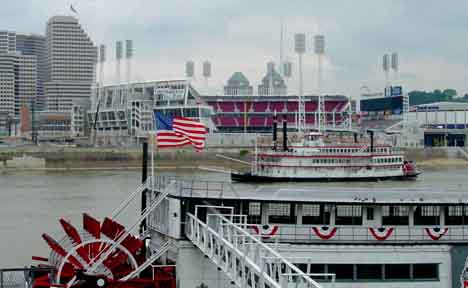 |
| The Ohio River is an integral aspect of the city of Cincinnati, and the Great American Ball Park’s proximity to the river is a real plus |
The Setting
There are some real positives regarding the location of the Reds’ new park — and some distinct negative ones. First, I really like stadiums that are either in the city’s downtown area or near a body of water. GABP scores on both points, as it is in downtown Cincinnati, and the Ohio River flows just beyond its right-field bleachers. Depending on your seat, you might have a pretty good view of the river and the hills of northern Kentucky beyond. The Roebling Suspension Bridge that crosses the Ohio just down river from the right-field foul pole is one of the most beautiful such structures in the country. There are also some wonderful views of the skyline and the Bengals’ new football stadium from the upper concourse, too.
The new park was wedged into a sliver of land between Cinergy Field and the city’s basketball/hockey arena — and it was a crowded fit. In fact, part of Cinergy’s outfield seats had to be removed before its final two seasons so that construction could commence on the new park. When I attended a game at GABP, they were still trucking away debris from the old stadium. I hear that some aesthetically pleasing things will be done with that space when it is fully developed, but for most of the new stadium’s first season, the area was simply an eyesore.
But there was one aspect of the setting that was truly unsettling to me. When my wife, son and I attended a weekday night game here, we stayed until the game was completed, and then headed to the surface lot between the baseball and football stadiums where we had parked. This lot appeared to be operated by either the team or city, and it cost $8.00 to park there. However, getting to that lot required some maneuvers through and around other areas where I did not feel safe at all. And there were no police or security officials anywhere to be seen. I definitely did not like the unsafe nature of this trek to our car, and this is a distinct mark against this park.
The Exterior
Again, for the Great American Ball Park’s first season, a great deal remains unfinished, especially on the west side of the park (where the old stadium used to be) and along the outer edge of the facility nearest the river.
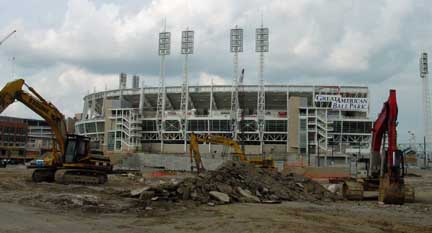 |
| During my visit, the rubble from Cinergy Field was still being removed |
The exterior itself refrains from the (perhaps overdone) “retro” look of red brick and exposed green girders. Instead, it has a modestly modern appearance, with light towers that truly do tower over the field. GABP’s exterior reminds one in many ways of Jacobs Field — and as is the case in Cleveland, it’s almost welcome to see a new ballpark not trying to look old!
The Design
When you first enter the stadium, one aspect is simply overwhelming: the seemingly endless red seats. Yes, every seat in the place is bright, bright red, and needless to say, this is not a relaxing, nostalgic look. While the game is going on, the areas where no fans are sitting (unfortunately, these areas seem to be growing as the team’s first season in the park progresses) seem to “glow red,” especially at a night game after the lights have taken full effect. I suppose that like the exterior, it’s nice to have a change of pace from the ubiquitous dark-green seats at almost every other ballpark built in the past 13 years, but the sea of red at the Great American Ball Park is indeed an interesting sight.
Like PNC Park in Pittsburgh (which also stayed away from green seats, using a pleasant blue instead), the park is oriented to take advantage of the view afforded by a busy river, as the Ohio River flows just beyond right and center fields. This means that the only upper decks are in left field, which does give the park a nice, asymmetrical feel (again, like PNC). By the way, the architectural heavyweights at HOK designed the parks in both Pittsburgh and Cincy.
The design aspect of GABP that has garnered the most attention — probably disproportionately so — is “the notch.” This is a gap in the seating sections where you can peer through to see some of downtown Cincinnati. Perhaps its inclusion was more for what it does on the outside, as fans walking to the park can see into the facility in a way that doesn’t exist at other baseball stadiums. Regardless, the notch is noteworthy, because it is a distinctive feature of this ballpark. Frankly, most other teams wouldn’t have permitted so many high-priced seats to be eliminated!
 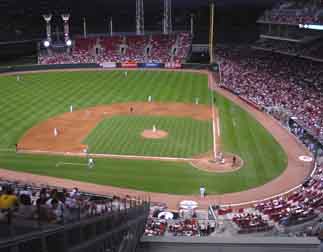 |
| As you look down the first-base line beyond home plate, you’ll see the break in the upper-deck stands dubbed “the notch.” The walkway spanning that notch provides an interesting photo opportunity (right). |
The concourses also deserve mention. I strongly prefer parks where fans can walk all the way around the field — especially while being able to see the action. Cincy’s new park does have a “360-degree concourse,” and this is a walk I recommend you take. Especially take note of the area beyond center field — not because you can get a look at Ken Griffey, Jr. (he’ll probably be out injured anyway), but because the views of the river are excellent, and the design of this area is unlike at any other park.
Another unusual aspect of the concourses is that only part of them are “open” (i.e., you can see the field from them). The typical new Major League park has an open concourse on the field level, and one where you can’t see the field at all on the upper level(s). In Cincinnati, though, the field-level concourse is “open” on the first-base side, but not on the third-base side (there are luxury suites there instead). On the upper level, there’s an open concourse on the third-base side, but not the first-base side. Very unusual.
And when considering whether to take a stroll all the way around the ballpark, note that some of the best views of the surrounding scenery are actually from the concourse — a la Safeco Field in Seattle — not from the within the main seating bowl. For instance, there are wonderful views of the river from the concourse in the outfield, you can see the beautiful new Bengals stadium from the upper-deck concourse behind first base, the downtown skyline looks great from the third-base concourse, etc. In other words, get up out of your seat and walk around the stadium!
The Essentials
So after scrutinizing the exterior look of the ballpark and its design, it’s time to talk about the really important elements! First, what about the food?
The selection is excellent, most certainly a significant upgrade from the Reds’ former home. You’ll find an impressive variety of foods, beers and sweets at the various stands — and you can bet you’ll be able to sample some of the city’s famous chili! Remember, this is a Major League ballpark, so expect to pay Major League prices for your food and drink.
There’s also an attractive restaurant called The Machine Room down the left-field foul line, and its food is excellent. The name of the establishment is a double play on words, as the interior looks like the inner workings of a factory, but the memorabilia around the restaurant celebrates the happiest years in the Reds’ history, when they were known as the Big Red Machine in the 1970s. The good news is that it is open to the general public. The bad news is that you can’t see the field from the majority of the tables.
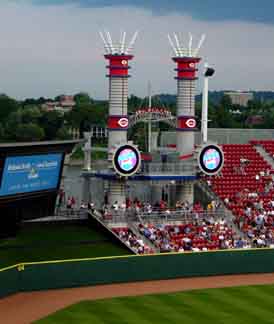 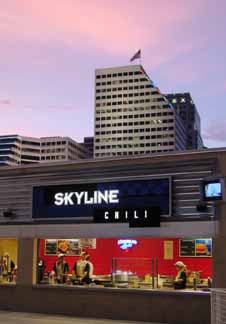 |
| Paying homage to the importance of river traffic to Cincinnati, there is a structure resembling a pair of sternwheeler smokestacks. Also, this is a city known for its chili! |
What about the way game information is communicated to the fans, you ask? The main scoreboard is high atop the left-field bleachers, and it features a lovely, high-resolution video screen on one end, a black-and-white message board on the other and a newsy area in the middle with both teams’ line ups, a running line score and the other essential game data. On top of it all is a cute clock.
But that’s not the only way the team can communicate visually with its fans. The facing of the upper deck has those very-wide-and-very-short, extremely bright screens that are all the rage in new hockey arenas. Maybe hockey fans like them, but I find them to be obnoxious. There are also two cute, circular color screens at the front of an interesting sternwheeler-esque structure in right-center field (see the photo). These are used to show the faces of Reds players.
During the team’s first season in the park, patrons who went searching for the main souvenir shop ended up walking in circles without success. That’s because the store hadn’t been constructed yet. However, with the old stadium now out of the way, a roomy gift shop will soon arrive on the main level on the first-base side. In the meantime, fans are able to buy souvenirs from various stands and the smaller stores on the middle and upper levels.
The price of the tickets reflects the fact that this is a so-called “small-market” franchise. In other words, they are pretty reasonable for a Major League team. In fact, the most expensive ticket in the upper deck is only $16. And there is no shortage of ticket-price choices, as there are no fewer than 17 different types of seats in GABP, not counting the areas for groups (note that if you’re attending a night game, the setting sun will be in your eyes if you sit in left field, which is different than most other baseball parks). With all of these different ticket prices, I guess you could say there’s something for every budget.
Similarly, the prices for parking vary widely, with an average of $8 in lots about a block from the stadium.
In Conclusion
So is the Great American Ball Park a step up for the Reds franchise? Clearly the answer is yes. It’s a baseball-only facility with nice (not fantastic, but nice) views of the Ohio River, excellent sight lines, natural-grass playing surface and improved food choices. And perhaps best of all for the tax payers of Cincinnati, the construction came in (slightly) under budget. But is it among the best of the new ballparks in the Majors? ‘Fraid not. While my descriptions of the park might make it sound like there are a lot of novel design elements, it really isn’t that exceptional compared to the really superlative baseball facilities in Pittsburgh, Denver, San Francisco or Seattle — nor is the view quite as nice. One fan remarked to me that so much energy and money went into the new football stadium that the baseball facility ended up getting shortchanged. Perhaps this is true, because Paul Brown Stadium, just a mile to the west of GABP, is stunning.
And, I hate to say, the scariness of getting to the parking lots after night games was another element that negatively impacted my assessment of the park.
Some of my complaints can’t be corrected, but some can … and my hope is that when all of the construction is complete around the park (including a large gift shop, team museum, more security and/or better walkways to the parking lots), attending a Reds game will truly be a safe, aesthetically pleasing occasion. Will the team compete again for a post-season berth anytime soon? Well … you can always eat dinner at The Machine Room and relive those old memories!